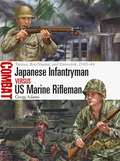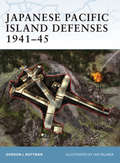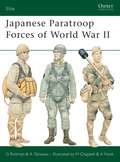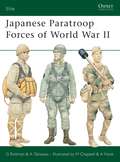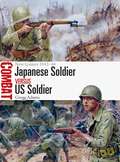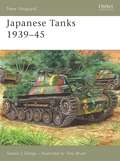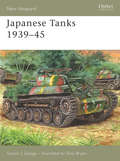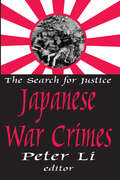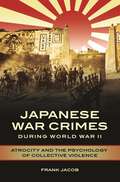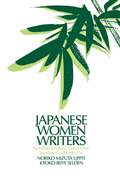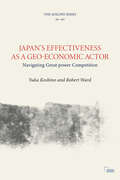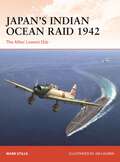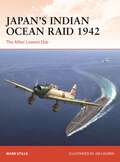- Table View
- List View
Japanese Infantryman vs US Marine Rifleman: Tarawa, Roi-Namur, and Eniwetok, 1943–44 (Combat #75)
by Gregg AdamsFeaturing evocative artwork plates and carefully selected photographs, this book assesses the US Marines and Japanese troops who contested the islands of Tarawa, Roi-Namur, and Eniwetok during 1943–44. On November 20, 1943, amphibious vehicles carrying Marines of the 2d Marine Division reached the shores of Betio Island in the Tarawa Atoll, defended by a determined Japanese garrison that would fight to the last man. This began a test by combat of over two decades of US studies, analyses, and planning for capturing and defending naval bases in Micronesia. The Tarawa assault was followed in February 1944 by the rapid capture of the Kwajalein and Eniwetok atolls in the Marshall Islands. In these battles US Marines fought a mix of Imperial Japanese Navy and Imperial Japanese Army ground units. All but a handful of the defenders, whether they were organized ground combat troops or infantry improvised from aviators and service troops, were determined to die for the Emperor while killing as many of the enemy as possible. In this study, Gregg Adams shows how the US Marine Corps and US Navy drew upon these pivotal actions to improve their tactics, organization, and equipment for the next round of amphibious operations. He also explains how their Japanese opponents – realizing that isolated island garrisons were doomed to destruction or isolation if the Imperial Japanese Navy could not defeat the US Navy at sea – moved from seeking to repel an invasion to one inflicting maximum American casualties through prolonged defensive fighting.
Japanese Pacific Island Defenses 1941–45 (Fortress #1)
by Gordon L. Rottman Ian PalmerThe prolonged and bloody fighting for control of the Japanese occupied Pacific islands in World War II is a key point in 20th-century warfare. No two islands were alike in the systems and nature of their defensive emplacements, and local improvization and command preferences affected both materials used and defensive models. This title details the establishment, construction and effectiveness of Japanese temporary and semi-permanent crew-served weapons positions and individual and small-unit fighting positions. Integrated obstacles and minefields, camouflage and the changing defensive principles are also covered.
Japanese Pacific Island Defenses 1941–45 (Fortress #1)
by Gordon L. Rottman Ian PalmerThe prolonged and bloody fighting for control of the Japanese occupied Pacific islands in World War II is a key point in 20th-century warfare. No two islands were alike in the systems and nature of their defensive emplacements, and local improvization and command preferences affected both materials used and defensive models. This title details the establishment, construction and effectiveness of Japanese temporary and semi-permanent crew-served weapons positions and individual and small-unit fighting positions. Integrated obstacles and minefields, camouflage and the changing defensive principles are also covered.
Japanese Paratroop Forces of World War II (Elite #127)
by Adam Hook Gordon L. Rottman Richard Hook Mike Chappell Akira TakizawaFor the first time in English, this book offers a concise but fact-packed account of the organization, equipment, and all operations of Japan's small but elite wartime parachute forces. Correcting and amplifying previous accounts based on wartime intelligence, it traces the Imperial Army's Raiding Regiments and the Imperial Navy's parachute-trained Yokosuka 1st & 3rd Special Naval Landing Forces from the first trials units, through their successful assaults in early 1942, to the last desperate battles and raids of 1944–45. Thetext is illustrated with rare photographs, and meticulouslyreconstructed color artworkof the men and their gear.
Japanese Paratroop Forces of World War II (Elite #127)
by Adam Hook Gordon L. Rottman Richard Hook Mike Chappell Akira TakizawaFor the first time in English, this book offers a concise but fact-packed account of the organization, equipment, and all operations of Japan's small but elite wartime parachute forces. Correcting and amplifying previous accounts based on wartime intelligence, it traces the Imperial Army's Raiding Regiments and the Imperial Navy's parachute-trained Yokosuka 1st & 3rd Special Naval Landing Forces from the first trials units, through their successful assaults in early 1942, to the last desperate battles and raids of 1944–45. Thetext is illustrated with rare photographs, and meticulouslyreconstructed color artworkof the men and their gear.
Japanese Soldier vs US Soldier: New Guinea 1942–44 (Combat)
by Gregg AdamsThis absorbing study pits US Army National Guardsmen against Japanese soldiers in the uniquely hostile setting of the New Guinea campaign in World War II.When Japanese forces attacked Pearl Harbor in December 1941, New Guinea – the world's second-largest island – was administered partly by Australia and partly by the Dutch East Indies. The New Guinea campaign (January 1942–August 1945) saw Japanese forces invade the island, rapidly capturing the key port of Rabaul and threatening Port Moresby, while US forces joined the defenders in increasing numbers. The uniquely demanding environment, and the savage nature of the fighting, meant that the campaign was among the most arduous of World War II for both sides. In this study, the Japanese forces and their US Army opponents, many of whom were National Guard units, are assessed and compared, with particular attention paid to combat doctrine, weaponry, tactics, logistics, leadership, and communications in the challenging setting of New Guinea. The role of US Army National Guard units and their Japanese opponents in three important battles are examined, namely Buna–Gona (November 1942–January 1943), Biak Island (May–August 1944) and the Driniumor River (July–August 1944).
Japanese Soldier vs US Soldier: New Guinea 1942–44 (Combat)
by Gregg AdamsThis absorbing study pits US Army National Guardsmen against Japanese soldiers in the uniquely hostile setting of the New Guinea campaign in World War II.When Japanese forces attacked Pearl Harbor in December 1941, New Guinea – the world's second-largest island – was administered partly by Australia and partly by the Dutch East Indies. The New Guinea campaign (January 1942–August 1945) saw Japanese forces invade the island, rapidly capturing the key port of Rabaul and threatening Port Moresby, while US forces joined the defenders in increasing numbers. The uniquely demanding environment, and the savage nature of the fighting, meant that the campaign was among the most arduous of World War II for both sides. In this study, the Japanese forces and their US Army opponents, many of whom were National Guard units, are assessed and compared, with particular attention paid to combat doctrine, weaponry, tactics, logistics, leadership, and communications in the challenging setting of New Guinea. The role of US Army National Guard units and their Japanese opponents in three important battles are examined, namely Buna–Gona (November 1942–January 1943), Biak Island (May–August 1944) and the Driniumor River (July–August 1944).
Japanese Special Naval Landing Forces: Uniforms and equipment 1932–45 (Men-at-Arms)
by Christa Hook Gary Nila Robert A. RolfeThe Imperial Japanese Navy's Special Landing Force units enjoyed a reputation out of proportion to their small size. Often wrongly termed “Imperial Marines”, they were in fact sailors led by Naval officers, and traced their origins directly to landing parties from warships. Their true combat debut was at Shanghai in 1932; thereafter the SNLF expanded and fought in the assaults that followed Pearl Habor in 1941, and were dispersed as island garrisons during the Pacific campaigns. This book describes their uniforms and equipment in unprecedented detail, including color photos of original items from private collections.
Japanese Special Naval Landing Forces: Uniforms and equipment 1932–45 (Men-at-Arms)
by Christa Hook Gary Nila Robert A. RolfeThe Imperial Japanese Navy's Special Landing Force units enjoyed a reputation out of proportion to their small size. Often wrongly termed "Imperial Marines†?, they were in fact sailors led by Naval officers, and traced their origins directly to landing parties from warships. Their true combat debut was at Shanghai in 1932; thereafter the SNLF expanded and fought in the assaults that followed Pearl Habor in 1941, and were dispersed as island garrisons during the Pacific campaigns. This book describes their uniforms and equipment in unprecedented detail, including color photos of original items from private collections.
Japanese Tanks 1939–45 (New Vanguard)
by Steven J. Zaloga Peter BullThe Japanese Army used tanks to great effect in the build-up to World War II. Inspired by European designs, in the 1920s and 1930s an innovative Japanese tank program facilitated their campaigns in China prior to the Pacific War. During the ensuing war against the Allies tanks were deployed imaginatively in jungle terrain previously thought impassable by such vehicles, being integral in Malaya and the capture of Singapore. Steven J Zaloga uses detailed and colorful artwork and photographs to explore these designs, explaining their neglect in favor of the naval priorities that left Japanese tanks outmoded by Western designs.
Japanese Tanks 1939–45 (New Vanguard #137)
by Steven J. Zaloga Peter BullThe Japanese Army used tanks to great effect in the build-up to World War II. Inspired by European designs, in the 1920s and 1930s an innovative Japanese tank program facilitated their campaigns in China prior to the Pacific War. During the ensuing war against the Allies tanks were deployed imaginatively in jungle terrain previously thought impassable by such vehicles, being integral in Malaya and the capture of Singapore. Steven J Zaloga uses detailed and colorful artwork and photographs to explore these designs, explaining their neglect in favor of the naval priorities that left Japanese tanks outmoded by Western designs.
Japanese War Crimes
by Peter LiThe question of national responsibility for crimes against humanity became an urgent topic due to the charge of ethnic cleansing against the previous Yugoslav government. But that was not the first such urging of legal and moral responsibility for war crimes. While the Nazi German regime has been prototypical, the actions of the Japanese military regime have been receiving increasing prominence and attention. Indeed, Peter Li's volume examines the phenomenon of denial as well as the deeds of destruction.Certainly one of the most troublesome unresolved problems facing many Asian and Western countries after the Asia Pacific war (1931u1945) is the question of the atrocities committed by the Japanese Imperial Army throughout Asia and the Japanese government's repeated attempts to whitewash their wartime responsibilities. The psychological and physical wounds suffered by victims, their families, and relations remain unhealed after more than half a century, and the issue is now pressing. This collection undertakes the critical task of addressing some of the multifaceted and complex issues of Japanese war crimes and redress.This collection is divided into five themes. In "It's Never Too Late to Seek Justice," the issues of reconciliation, accountability, and Emperor Hirohito's responsibility for war crimes are explored. "The American POW Experience Remembered" includes a moving account of the Bataan Death March by an American ex-soldier. "Psychological Responses" discusses the socio-psychological affects of the Nanjing Massacre and Japanese vivisection on Chinese subjects. The way in which Japanese war atrocities have been dealt with in the theater and cinema is the focus of "Artistic Responses." And central to "History Must not Forget" are the questions of memory, trauma, biological warfare, and redress. Included in this volume are samples of the many presentations given at the International Citizens' Forum on War Crimes and Redress held in Tokyo in Decem
Japanese War Crimes
by Peter LiThe question of national responsibility for crimes against humanity became an urgent topic due to the charge of ethnic cleansing against the previous Yugoslav government. But that was not the first such urging of legal and moral responsibility for war crimes. While the Nazi German regime has been prototypical, the actions of the Japanese military regime have been receiving increasing prominence and attention. Indeed, Peter Li's volume examines the phenomenon of denial as well as the deeds of destruction.Certainly one of the most troublesome unresolved problems facing many Asian and Western countries after the Asia Pacific war (1931u1945) is the question of the atrocities committed by the Japanese Imperial Army throughout Asia and the Japanese government's repeated attempts to whitewash their wartime responsibilities. The psychological and physical wounds suffered by victims, their families, and relations remain unhealed after more than half a century, and the issue is now pressing. This collection undertakes the critical task of addressing some of the multifaceted and complex issues of Japanese war crimes and redress.This collection is divided into five themes. In "It's Never Too Late to Seek Justice," the issues of reconciliation, accountability, and Emperor Hirohito's responsibility for war crimes are explored. "The American POW Experience Remembered" includes a moving account of the Bataan Death March by an American ex-soldier. "Psychological Responses" discusses the socio-psychological affects of the Nanjing Massacre and Japanese vivisection on Chinese subjects. The way in which Japanese war atrocities have been dealt with in the theater and cinema is the focus of "Artistic Responses." And central to "History Must not Forget" are the questions of memory, trauma, biological warfare, and redress. Included in this volume are samples of the many presentations given at the International Citizens' Forum on War Crimes and Redress held in Tokyo in Decem
Japanese War Crimes during World War II: Atrocity and the Psychology of Collective Violence
by Frank JacobA challenging examination of Japanese war crimes during World War II offers a fresh perspective on the Pacific War—and a better understanding of reasons for the wartime use of extreme mass violence.The 1937 Rape of Nanjing has become a symbol of Japanese violence during the Second World War, but it was not the only event during which the Japanese used extreme force. This thought-provoking book analyzes Japan's actions during the war, without blaming Japan, helping readers understand what led to those eruptions. In fact, the author specifically disputes the idea that the forms of extreme violence used in the Pacific War were particularly Japanese.The volume starts by examining the Rape of Nanjing, then goes on to address Japan's acts of individual and collective violence throughout the conflict. Unlike other works on the subject, it combines historical, sociological, and psychological perspectives on violence with a specific study of the Japanese army, seeking to define the reasons for the use of extreme violence in each particular case. Both a historical survey and an explanation of Japanese warfare, the book scrutinizes incidents of violence perpetrated by the Japanese vis-à-vis theories that explore the use of violence as part of human nature. In doing so, it provides far-reaching insights into the use of collective violence and torture in war overall, as well as motivations for committing atrocities. Finally, the author discusses current political implications stemming from Japan's continued refusal to acknowledge its war-time actions as war crimes.
Japanese War Crimes during World War II: Atrocity and the Psychology of Collective Violence
by Frank JacobA challenging examination of Japanese war crimes during World War II offers a fresh perspective on the Pacific War—and a better understanding of reasons for the wartime use of extreme mass violence.The 1937 Rape of Nanjing has become a symbol of Japanese violence during the Second World War, but it was not the only event during which the Japanese used extreme force. This thought-provoking book analyzes Japan's actions during the war, without blaming Japan, helping readers understand what led to those eruptions. In fact, the author specifically disputes the idea that the forms of extreme violence used in the Pacific War were particularly Japanese.The volume starts by examining the Rape of Nanjing, then goes on to address Japan's acts of individual and collective violence throughout the conflict. Unlike other works on the subject, it combines historical, sociological, and psychological perspectives on violence with a specific study of the Japanese army, seeking to define the reasons for the use of extreme violence in each particular case. Both a historical survey and an explanation of Japanese warfare, the book scrutinizes incidents of violence perpetrated by the Japanese vis-à-vis theories that explore the use of violence as part of human nature. In doing so, it provides far-reaching insights into the use of collective violence and torture in war overall, as well as motivations for committing atrocities. Finally, the author discusses current political implications stemming from Japan's continued refusal to acknowledge its war-time actions as war crimes.
Japanese Women Writers: Twentieth Century Short Fiction
by Kyoko Iriye Selden Noriko Mizuta Lippit"Here are Japanese women in infinite and fascinating variety -- ardent lovers, lonely single women, political activists, betrayed wives, loyal wives, protective mothers, embittered mothers, devoted daughters. ... a new sense of the richness of Japanese women's experience, a new appreciation for feelings too long submerged". -- The New York Times Book Review
Japanese Women Writers: Twentieth Century Short Fiction (Japan In The Modern World Ser.)
by Kyoko Iriye Selden Noriko Mizuta Lippit"Here are Japanese women in infinite and fascinating variety -- ardent lovers, lonely single women, political activists, betrayed wives, loyal wives, protective mothers, embittered mothers, devoted daughters. ... a new sense of the richness of Japanese women's experience, a new appreciation for feelings too long submerged". -- The New York Times Book Review
Japan's Asian Allies 1941–45 (Men-at-Arms)
by Philip JowettDuring the Japanese occupation of large parts of Asia and the Pacific in 1941–45, Japan raised significant numbers of troops to fight alongside them, as well as militias to guard their conquests. The total number of these soldiers is estimated at no fewer than 600,000 men. These ranged from the regular troops of Manchukuo (200,000 men), Nanking China (250,000), Thailand, and recruits from the 'puppet' Burmese Independence Army (30,000) and Indian National Army (40,000), to constabularies and spear-wielding militias in the Philippines (15,000), Borneo, Indonesia and New Guinea.Many of the recruits from former European colonies hoped for independence as part of the 'Greater East-Asian Co-Prosperity Sphere' proclaimed by Japanese propaganda, but Japan's intentions were entirely cynical. They formed alliances to deny the Allied powers access to territory that they could not actually occupy, and raised these large numbers of auxiliary troops to relieve the manpower burden of occupation, or simply as 'cannon-fodder'.This extensively researched study examines each of these armies and militias in detail, exploring their history and deployment during World War II, and revealing the intricacies of their arms and equipment with stunning full-colour artwork and previously unpublished contemporary photographs.
Japan's Asian Allies 1941–45 (Men-at-Arms #532)
by Philip JowettDuring the Japanese occupation of large parts of Asia and the Pacific in 1941–45, Japan raised significant numbers of troops to fight alongside them, as well as militias to guard their conquests. The total number of these soldiers is estimated at no fewer than 600,000 men. These ranged from the regular troops of Manchukuo (200,000 men), Nanking China (250,000), Thailand, and recruits from the 'puppet' Burmese Independence Army (30,000) and Indian National Army (40,000), to constabularies and spear-wielding militias in the Philippines (15,000), Borneo, Indonesia and New Guinea.Many of the recruits from former European colonies hoped for independence as part of the 'Greater East-Asian Co-Prosperity Sphere' proclaimed by Japanese propaganda, but Japan's intentions were entirely cynical. They formed alliances to deny the Allied powers access to territory that they could not actually occupy, and raised these large numbers of auxiliary troops to relieve the manpower burden of occupation, or simply as 'cannon-fodder'.This extensively researched study examines each of these armies and militias in detail, exploring their history and deployment during World War II, and revealing the intricacies of their arms and equipment with stunning full-colour artwork and previously unpublished contemporary photographs.
Japan’s Effectiveness as a Geo-Economic Actor: Navigating Great-Power Competition (Adelphi series)
by Yuka Koshino Robert WardGeo-economic strategy – deploying economic instruments to secure foreign-policy aims and to project power – has long been a key element of statecraft. In recent years, it has acquired even greater salience given China’s growing antagonism with the United States and the willingness of both Beijing and Washington to wield economic power in their confrontation. This trend has particular significance for Japan given its often tense political relationship with China, which remains its largest trading partner. While Japan’s post-war geo-economic performance often failed to match its status as one of the world’s largest economies, more recently Tokyo has demonstrated increased geo-economic agency and effectiveness. In this Adelphi book, Yuka Koshino and Robert Ward draw on multiple disciplines – including economics, political economy, foreign policy and security policy – and interviews with key policymakers to examine Japan’s geo-economic power in the context of great-power competition between the US and China. They examine Japan’s previous underperformance, how Tokyo’s understanding of geo-economics has evolved and, given constraints on its national power-projection, what actions Japan might feasibly take to become a more effective geo-economic actor. Their conclusions will be of direct interest not only for all those concerned with Japanese grand strategy and the Asia-Pacific, but also for those middle powers seeking to navigate great-power competition in the coming decades.
Japan’s Effectiveness as a Geo-Economic Actor: Navigating Great-Power Competition (Adelphi series)
by Yuka Koshino Robert WardGeo-economic strategy – deploying economic instruments to secure foreign-policy aims and to project power – has long been a key element of statecraft. In recent years, it has acquired even greater salience given China’s growing antagonism with the United States and the willingness of both Beijing and Washington to wield economic power in their confrontation. This trend has particular significance for Japan given its often tense political relationship with China, which remains its largest trading partner. While Japan’s post-war geo-economic performance often failed to match its status as one of the world’s largest economies, more recently Tokyo has demonstrated increased geo-economic agency and effectiveness. In this Adelphi book, Yuka Koshino and Robert Ward draw on multiple disciplines – including economics, political economy, foreign policy and security policy – and interviews with key policymakers to examine Japan’s geo-economic power in the context of great-power competition between the US and China. They examine Japan’s previous underperformance, how Tokyo’s understanding of geo-economics has evolved and, given constraints on its national power-projection, what actions Japan might feasibly take to become a more effective geo-economic actor. Their conclusions will be of direct interest not only for all those concerned with Japanese grand strategy and the Asia-Pacific, but also for those middle powers seeking to navigate great-power competition in the coming decades.
Japan’s Indian Ocean Raid 1942: The Allies' Lowest Ebb (Campaign #396)
by Mark StilleAn detailed illustrated exploration of the Japanese raid into the Indian Ocean in April 1942 – one of the largest operations conducted by the Imperial Navy during the war.In the wake of Japan's conquest of Burma in early 1942, plans were formed by the Imperial high command to capture Ceylon (modern Sri Lanka) to consolidate Japan's defensive perimeter and disrupt British shipping lanes to India, Australia, and the Middle East. The Imperial Japanese Army, however, could not release sufficient troops for an invasion, and so in response the Japanese Navy developed Operation C, an aggressive raid by the Combined Fleet into the Indian Ocean. The key objective was to destroy the British Eastern Fleet in port.Expert naval historian Mark Stille documents the high point of Japanese naval air power as its carriers struck Ceylon – the heart of British naval power in the East – sinking several Allied ships. He describes the Allied air attempts to destroy Admiral Chuichi Nagumo's force, and the Japanese attacks against British shipping and the cities along the Indian coast.Specially commissioned battlescenes bring to life the sinking of British carrier Hermes, the Bristol Blenheim attacks on the Japanese carrier force, and a Zero vs Hurricane dogfight over Colombo on 5 April. Easy to follow maps and diagrams reveal the strategic situation at the start and end of the campaign, and track the movements of the Japanese carrier task force and the British Eastern Fleet throughout. Details of weaponry, equipment, personnel and the events of the fascinating battles that took place are revealed in over 60 photographs, many of which are from Japanese sources.
Japan’s Indian Ocean Raid 1942: The Allies' Lowest Ebb (Campaign #396)
by Mark StilleAn detailed illustrated exploration of the Japanese raid into the Indian Ocean in April 1942 – one of the largest operations conducted by the Imperial Navy during the war.In the wake of Japan's conquest of Burma in early 1942, plans were formed by the Imperial high command to capture Ceylon (modern Sri Lanka) to consolidate Japan's defensive perimeter and disrupt British shipping lanes to India, Australia, and the Middle East. The Imperial Japanese Army, however, could not release sufficient troops for an invasion, and so in response the Japanese Navy developed Operation C, an aggressive raid by the Combined Fleet into the Indian Ocean. The key objective was to destroy the British Eastern Fleet in port.Expert naval historian Mark Stille documents the high point of Japanese naval air power as its carriers struck Ceylon – the heart of British naval power in the East – sinking several Allied ships. He describes the Allied air attempts to destroy Admiral Chuichi Nagumo's force, and the Japanese attacks against British shipping and the cities along the Indian coast.Specially commissioned battlescenes bring to life the sinking of British carrier Hermes, the Bristol Blenheim attacks on the Japanese carrier force, and a Zero vs Hurricane dogfight over Colombo on 5 April. Easy to follow maps and diagrams reveal the strategic situation at the start and end of the campaign, and track the movements of the Japanese carrier task force and the British Eastern Fleet throughout. Details of weaponry, equipment, personnel and the events of the fascinating battles that took place are revealed in over 60 photographs, many of which are from Japanese sources.
Japan's New Imperialism
by Rob StevenA full scale examination of the 1979 Sino-Vietnamese War - the events that led to it, the Cold War aftermath, and the implications for the region and beyond.
Japan's New Imperialism (Japan In The Modern World Ser.)
by Rob StevenA full scale examination of the 1979 Sino-Vietnamese War - the events that led to it, the Cold War aftermath, and the implications for the region and beyond.
